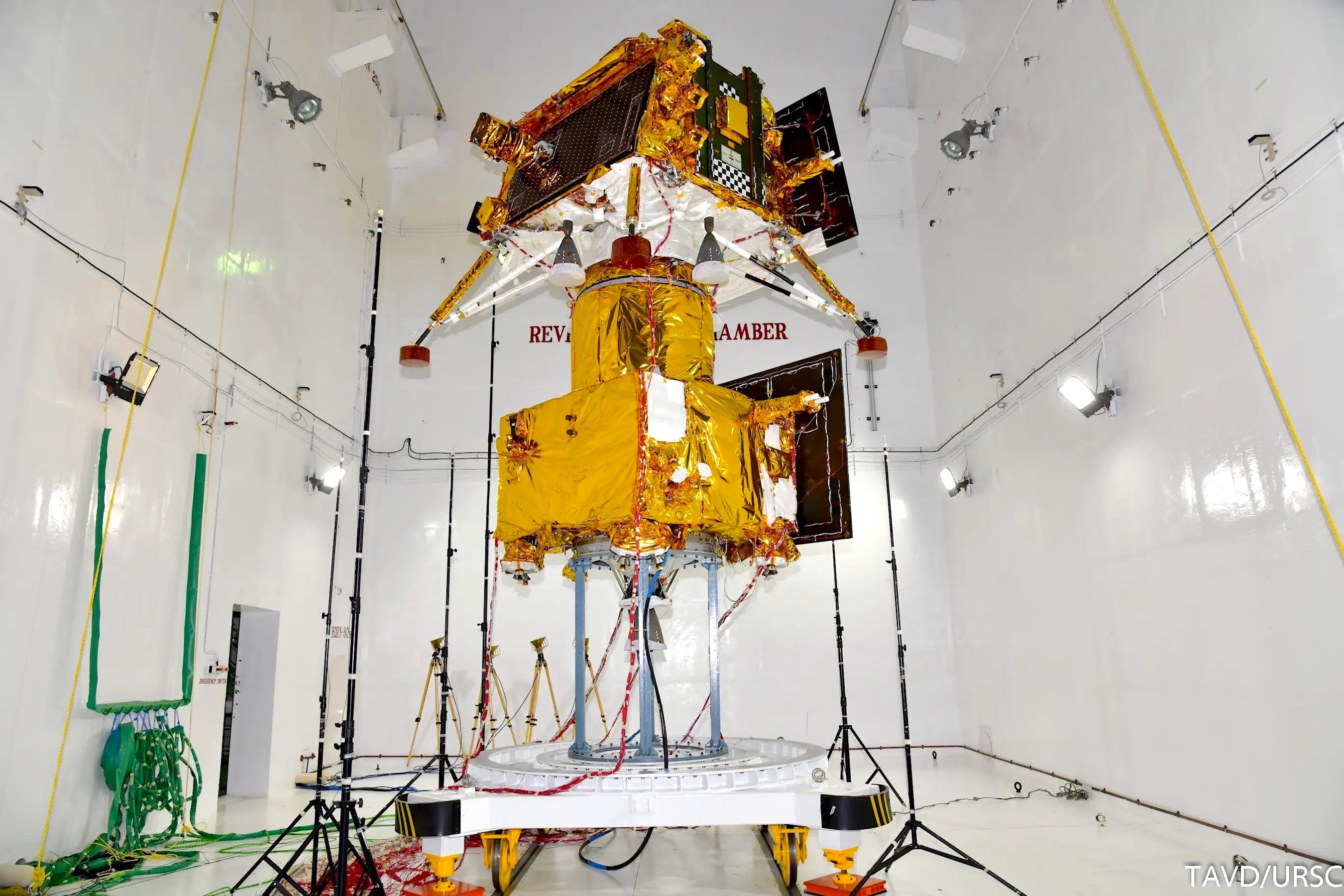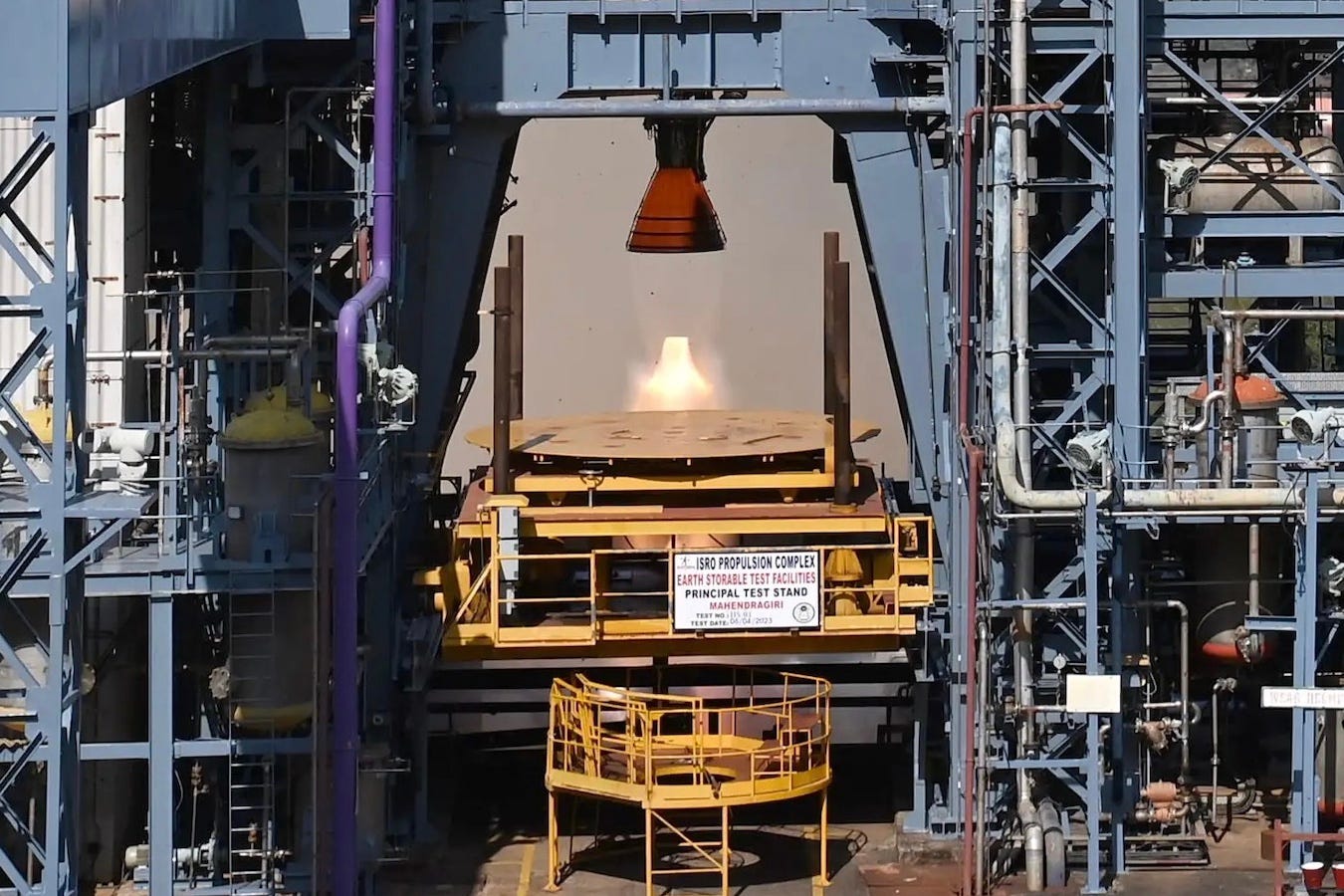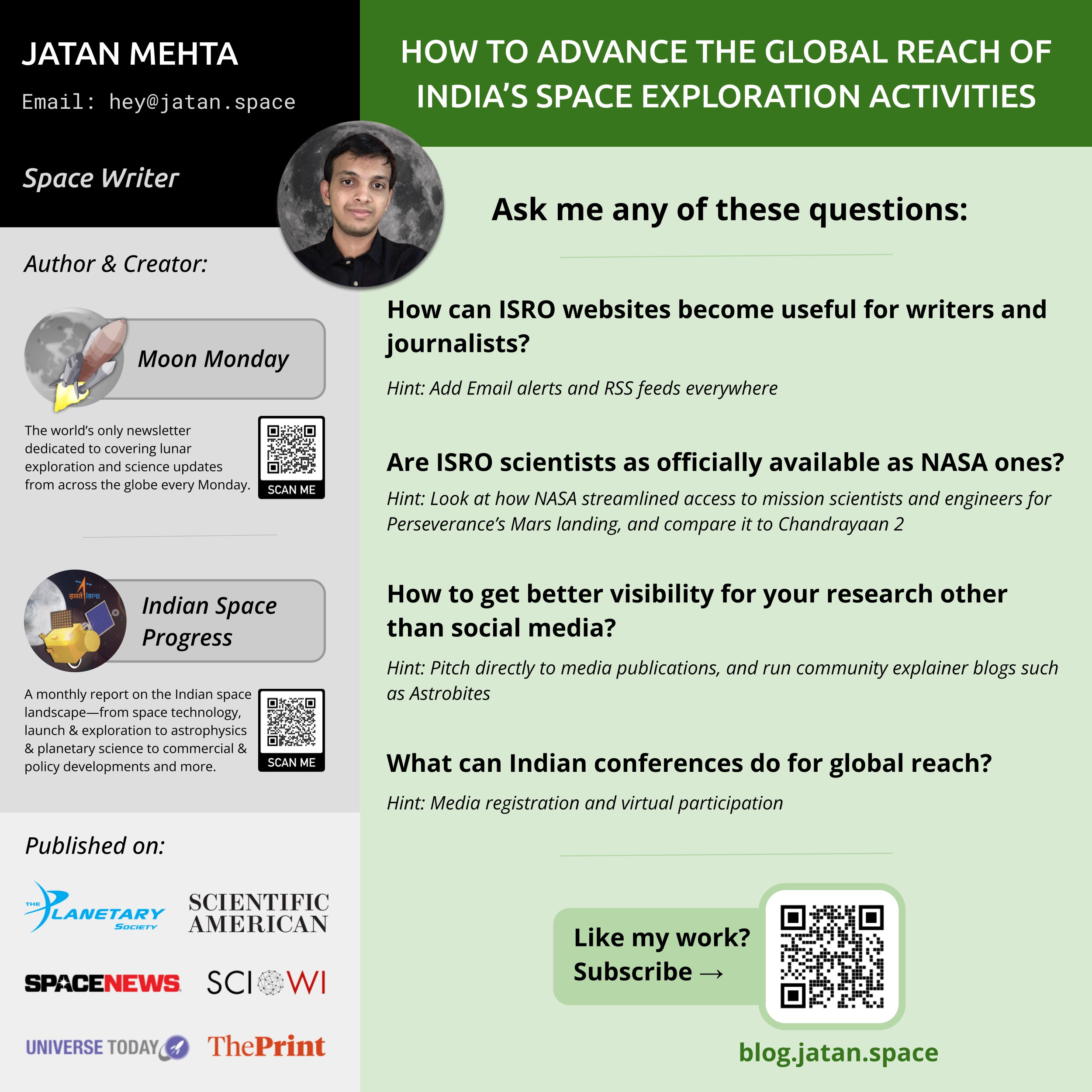Indian Space Progress #3: ISRO’s approach to commercial launch, Chandrayaan 3 liftoff in sight, Gaganyaan engines, mission updates, and more
At ~2,000 words, this edition is filled with updates and context on what has been a buzzing March for Indian space. I hope you enjoy reading it as much as I did trying to make sense of it all. :)
ISRO solidifies its commercial leg with second launch for OneWeb

An Indian GSLV Mk III rocket launched and deployed 36 OneWeb satellites on March 26, marking ISRO’s second commercial launch for the UK firm. ISRO’s fleet of rockets exist first and foremost to give India independence from foreign launchers. But they also offer commercial opportunities, as illustrated by the OneWeb launches.
Russia’s invasion of Ukraine in February 2022 terminated OneWeb’s launch arrangement with Roscosmos, which had already launched 428 satellites for the company aboard Soyuz rockets. India seized the opportunity by offering OneWeb prioritized rides to meet the company’s urgent need. New Space India Limited (NSIL), a Department of Space company tasked with commercializing Indian space technologies, negotiated on behalf of ISRO and won the two OneWeb contracts at $60 million per launch—just under the $67 million price tag of a dedicated SpaceX Falcon 9.
ISRO has launched the Mk III six times now, all successful. At ~6,000 kilograms each, the two OneWeb launches were the heaviest payloads ever carried on an Indian rocket. ISRO is working on increasing Mk III’s payload capacity further to complement its workhorse, medium-lift PSLV rocket. The agency is also human-rating the Mk III to launch astronauts by mid-decade for project Gaganyaan, which would make the rocket more reliable.
As of its last flight on November 26, the PSLV has launched 348 satellites for 36 countries since its first commercial launch in 1999. To keep the vehicle relevant amid increasing global launch competition, NSIL awarded a $104 million contract in September to a consortium of major PSLV contractors to have fully industry-built PSLVs with increased production rates and reduced prices.
In parallel, with a successful launch this February, ISRO’s new modular SSLV rocket is set to enter the cut-throat smallsat market with a lower target price and quicker turnaround than Rocket Lab’s Electron. NSIL aims to offer as many as ten SSLV launches a year by 2026.
Evidently, the primary factor limiting commercial success for Indian rockets isn’t pricing but launch frequency. India can currently produce a Mk III every six to eight months. NSIL and ISRO want to cut that in half by 2025. But even when coupled with increased production rates of the PSLV and SSLV, the country simply has no plans to launch as amply as the Falcon 9.
Again, all of ISRO’s rockets exist primarily to serve India’s national interests, including civil needs. The Mk III was particularly created to drastically reduce India’s dependence on Europe-based Arianespace for launching its heaviest satellites. In fact, ISRO Chief S. Somanath said in a post-launch briefing that the Mk III used for the March 26 lift of OneWeb satellites debuted upgraded solid rocket boosters with increased margins. These are designed for future Gaganyaan flights, and are thus being tested ahead of time.
As such, once operational for the nation’s own needs, ISRO’s fleet of rockets are offered commercially. The MK III’s orbital loft of OneWeb satellites solidifies ISRO’s small but definitive place in the global space launch market.
This section was originally published on Payload, and is extended and tweaked for my blog.
Chandrayaan 3 liftoff in sight

As part of an ongoing series of standard space simulating tests, India’s Chandrayaan 3 Moon lander successfully completed its launch survival testing early March. This test checks in a special acoustic chamber if the spacecraft structure can withstand the intense, sustained sounds and vibrations of its rocket launch. At the 4th Indian Planetary Science Conference (IPSC) last month, ISRO Chief S. Somanath said that the agency is targeting Chandrayaan 3’s launch by July.
Somanath added that the joint Indo-Japanese LUPEX Moon mission will launch in the 2026–2028 timeframe. The mission’s ISRO-developed lander will deliver JAXA’s ~350-kilogram, drill-capable rover to the Moon’s south pole to study water ice. LUPEX, similarly to NASA’s VIPER rover, aims to help scientists unravel the physical and chemical nature of the Moon’s water ice deposits, assess their resource potential, and determine how accessible they really are to help us plan future crewed missions.
Related updates:
- ISRO organized a workshop on March 28–29 to train students and researchers on lunar science and data analysis, especially for the expected in-situ measurements from the instruments on the Chandrayaan 3 lander and rover respectively.
- Rishitosh Sinha from the Physical Research Laboratory said in his IPSC talk that Chandrayaan 3’s alternate landing site is at 69.49° S, 17.33° W. Also see: Chandrayaan 3’s primary landing site
On India and Artemis
In an interview with Interstellar News, ISRO Chief S. Somanath said that the agency has submitted an internal report to the Indian government regarding possible stances the country could take on the US-led Artemis Accords. However, Somanath also mentioned that “signing the Accords is a prerequisite for participating in Artemis.” This, in the eyes of his team, complicates the decision-making process for India to collaborate on Artemis lunar missions. But said condition may not be true, or is at least murky, because Marcia Smith reported in December 2022 that the U.S. is pushing for broad international acceptance of the Accords independent of a nation’s desire to collaborate with NASA on Artemis itself.
Relatedly, a talk during the 54th Lunar and Planetary Science Conference last month demonstrates such a collaborative end. Wes Patterson described how his team is using complementary radar data from NASA’s Lunar Reconnaissance Orbiter and ISRO’s Chandrayaan 2 orbiter to uniquely characterize the 13 candidate lunar south polar landing zones for NASA’s historic return of humans to our Moon with Artemis III by mid-decade. The output from this work includes getting valuable information on landing hazards within those sites, better access to their permanently shadowed regions than optical imagers for lunar water-related mission goals, and gaining a broad sense of the physical states of the regions from inferred physical properties. It effectively illustrates how a NASA-ISRO collaboration for Artemis represents an untapped opportunity.
Many thanks to the Takshashila Institution and SkyServe for sponsoring this month’s Indian Space Progress report.
Thanks also to James Tuttle Keane for supporting my independent writing.
Upcoming mission updates

ISRO is targeting launch of Singapore’s 750-kilogram TeLEOS 2 synthetic aperture radar (SAR) satellite on a PSLV rocket end of April. Several other smallsats, including a 3D-printed PILOT payload, will fly as rideshares.
On March 6, NASA air-delivered to ISRO the integrated SAR payloads for the NASA-ISRO Synthetic Aperture Radar (NISAR) Earth observation satellite. This completes a major milestone for the joint project, which is among the most expensive at $1.5 billion. NISAR’s L-band SAR is being provided by NASA JPL while the S-band SAR is from ISRO. Next up, ISRO will integrate the payloads and associated NASA-provided avionics into the homegrown satellite bus. Over the course of its three-year primary mission post-launch in Q1 2024, NISAR’s first-of-its-kind dual-frequency radar imaging system will observe nearly our entire planet every 12 days to reveal ongoing changes in Earth’s crust, polar ice, climatic processes, biomass, agricultural regions, and more. The satellite will also be used for disaster management, whereby its data will be available only a few hours after observations. ISRO and NASA have said that all science data from the mission will be in the public domain.
Contrary to earlier reports of a launch delay, ISRO Chief S. Somanath said during his IPSC talk that ISRO has received all instruments of the Aditya-L1 solar observatory, and that the mission’s launch is still targeted for mid-year. That does align with a response in the Indian Parliament, which says the PSLV rocket after the one launching TeLEOS2 is designated for Aditya-L1.
In his talk, Somanath also mentioned that ISRO is considering the 2028 launch window for its upcoming Venus orbiter mission Shukrayaan. He was concerned about the science aspect of Gaganyaan: “I haven’t seen many good scientific objectives coming out of Gaganyaan. We need to work on this.”
Engines for human spaceflight

As ISRO works towards the ambitious inaugural Gaganyaan mission to indigenously send humans to space, advances continue on qualifying technologies needed to achieve said feat. On April 6, ISRO completed human-rating the liquid-fueled Vikas engine, two of which power the core stage of the GSLV Mk III. The qualification campaign, which took place over 3 years, comprised several long duration hot fire tests of a modified Mk III Vikas engine, which has higher structural margins, better health monitoring, and redundancy in many of its associated systems. These tests also had intentionally off-nominal fuel ratios and thrust levels to broaden safety limits.
So that was the lift end of the Gaganyaan equation, but the agency has been progressing on the earthly descent phase as well. On April 5, ISRO successfully tested a full 650-second burn of the twelve 100-Newton thrusters which will power the Crew Module during Gaganyaan missions to provide controlled atmospheric descent. ISRO also continued parachute deployment tests last month, and received a simulated Crew Module structure for performing air-drop tests soon.
The commercial push continues
- IN-SPACe, a Department of Space entity created to promote, regulate, and authorize activities of private Indian space organizations, is providing up to ~$120,000 in seed funding to innovative new startups. Relatedly, IN-SPACe is also establishing a Design Lab, where space startups can access comprehensive, high-performance space simulation suites without having to own their own.
- As part of the growing Indian-Australian collaboration in space, the Australian Space Agency is providing a total of $20.7 million in funding to Aussie businesses and research organizations for specifically conducting joint projects with Indian space entities anywhere across the space technology spectrum.
- On March 31, private firm Skyroot Aerospace successfully hot fired a 3D-printed cryogenic second stage engine for their upcoming Vikram-II launch vehicle. Here’s the video.
More Indian space
- On April 2, ISRO successfully conducted the first autonomous, runway landing demonstration of an indigenously developed spaceplane, whose larger version will be part of a future Reusable Launch Vehicle. The spaceplane was dropped from a 4.5-kilometer altitude with initial conditions that simulate a reentry from space starting from that point. ISRO will now prepare to conduct a landing test with an actual orbital flight, but its timeline remains utterly unknown.
- Scientists at the Raman Research Institute, in partnership with ISRO, successfully demonstrated secure quantum communications between a stationary source and a moving receiver. Previously, ISRO demonstrated such communications between stationary ends last year. The ultimate goal it to have the technology on satellites.
- To accelerate the realization of ~100 specific space technology products ISRO needs for its upcoming missions, the agency has put out an open invite to the national industry to bid for the same. This move should enhance ISRO’s supplier network while also being a good opportunity for new private players.
- As a demonstration of safe space debris disposal, ISRO carefully de-orbited the 12-year old Megha-Tropiques-1 satellite on March 7. Related: Here’s a neat overview of progress on the Indian Space Situational Awareness front during 2022.
Presented at the Indian Planetary Science conference
I presented this poster at the 4th Indian Planetary Science Conference last month. Really, for civil space exploration missions, why is it that despite being an Indian citizen I have easy formal access to U.S. government space agency officials (NASA) but not ISRO? With this poster, I’ve tried to get the word out there more formally, and to more relevant people. Progress in public awareness of science is the progress of science, and that of a nation. Let us solve this.


